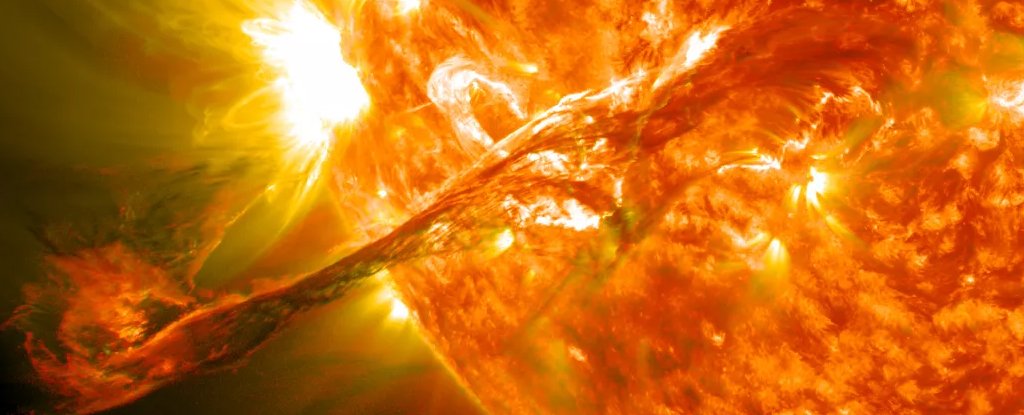Products You May Like
From afar, the Sun looks calm and peaceful in our daytime skies. But up close, it’s an erupting, chaotic display of solar activity the likes of which astrophysicists didn’t expect until the last year or so.
“We didn’t think the Sun was going to be as active this particular cycle, but the observations are completely opposite,” Andrew Gerrard, the department chair and director of the Center for Solar-Terrestrial Research at New Jersey Institute of Technology, told Business Insider.
Solar cycles typically occur every 11 years. Within that time, the Sun oscillates from minimum to maximum solar activity, with maximum activity peaking in the middle of the cycle when the Sun’s magnetic fields flip.
The last solar cycle was from 2008 to 2019. We’re now in the middle of the current solar cycle and are approaching maximum magnetic activity.
The heightened solar magnetic activity that’s been growing over the last several years is so strong that it chokes energy from deep inside the Sun, preventing it from reaching the surface. This causes cooler pockets on the solar surface that appear as dark splotches, known as sunspots.
Scientists like Gerrard can get an idea of solar activity levels by counting sunspots. They’ve been reaching record highs over the last year or so.
Earlier this month, NOAA reported that preliminary observations had found 299 sunspots that all appeared within 24 hours – the highest daily sunspot record in over 22 years if confirmed.
Tracking sunspots is important because they are ground zero for powerful X-class solar flares and massive eruptions called coronal mass ejections. These can pose threats to Earth, causing radio blackouts and power grid outages, disrupting GPS navigation, and even triggering satellites to fall from space.
Not all sunspots will produce an eruption and, when they do, not all eruptions pose a threat because they might miss Earth, Alex James, a solar physicist at the University of College London, told Business Insider over email.
Still, learning to predict solar storms ahead of time is an important field of ongoing research because it could give us more lead time to prepare, James said.
The Sun is more active than we thought
X-class solar flares and coronal mass ejections are beautiful to watch. But when they burst, they fling high-energy particles into space at speeds exceeding 1,000 mph. If Earth is in the way, there’s a chance those particles can interact with our planet’s magnetic field and upper atmosphere, causing geomagnetic storms.
Geomagnetic storms can spark beautiful aurora borealis and aurora australis – the Northern and Southern lights. These colorful displays have been showing up further south than usual, in states like Texas and Colorado. That’s because of the Sun’s increased activity.
But those high-energy particles are also like little gremlins that can cause all sorts of mayhem to high-frequency radio emissions that the military, airlines, and GPS systems rely on, Gerrard said.
Since January, geomagnetic storms have caused radio blackouts on four continents: North and South America, Europe, and Africa.
This can make your GPS temporarily act up. It can also lead to power outages as well as grounded flights and flight delays since the Federal Aviation Administration won’t allow planes to fly without both radio and satellite communications.
Another concern is spacecraft. “If there’s a coronal mass ejection, and if that material gets to the Earth, it’s going to make the densities in Earth’s upper atmosphere higher,” Gerrard said. “And that’s going to create more drag, and more drag is going to bring down spacecraft.”
In February 2022, a geomagnetic storm contributed to 38 Starlink satellites coming down from orbit. The satellites were in a lower, transitional orbit and hadn’t yet reached their final destination.
Scientists suspect that lower orbit combined with a geo-storm, causing them to fall from space and burn up in Earth’s atmosphere.
And last May, the largest geomagnetic storm to reach Earth in two decades led to degraded service from Starlink. No satellites fell out of orbit during that storm.
The Sun is reaching solar maximum
The Sun’s activity is expected to continue to increase until it reaches peak activity levels, which scientists call solar maximum.
“Current predictions suggest solar maximum will occur in the second half of 2025, but we’ll only really know when the true maximum has occurred after the activity starts to decline again,” James said.
Though this cycle’s solar maximum is projected to be stronger than scientists initially predicted, it’s “looking fairly average in a more historical context,” Mathew Owens, professor of space physics at the University of Reading, told BI over email.
Still, we’re likely more prone to the effects of solar maximum now than ever before because of our growing dependence on satellite technology, James said.
This article was originally published by Business Insider.
More from Business Insider:
